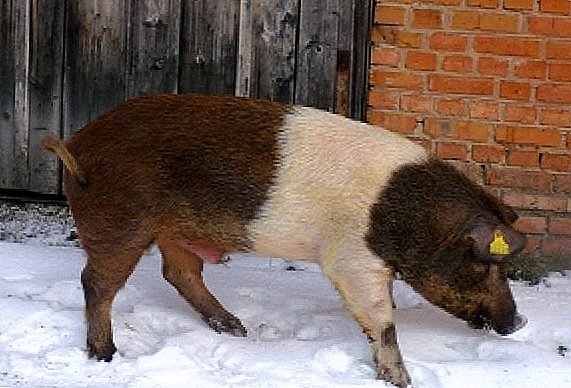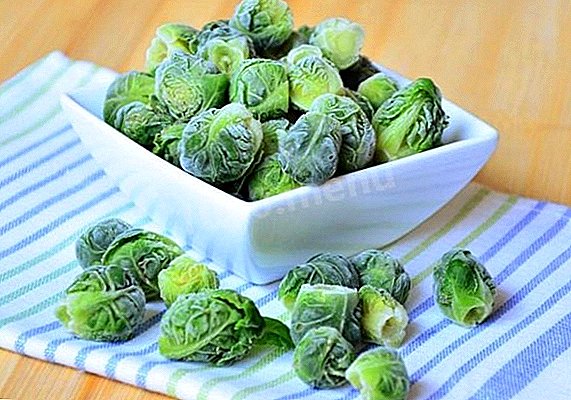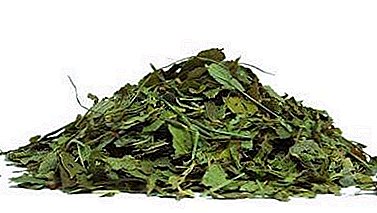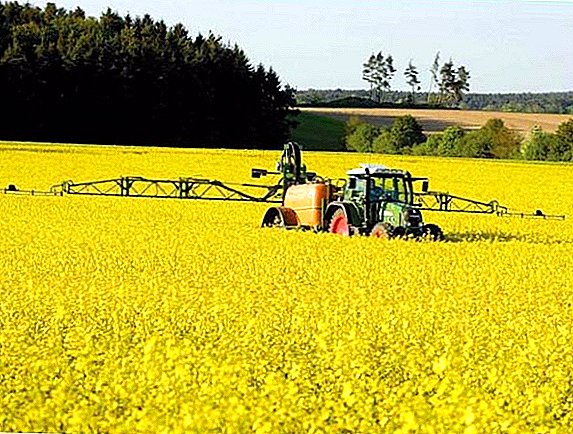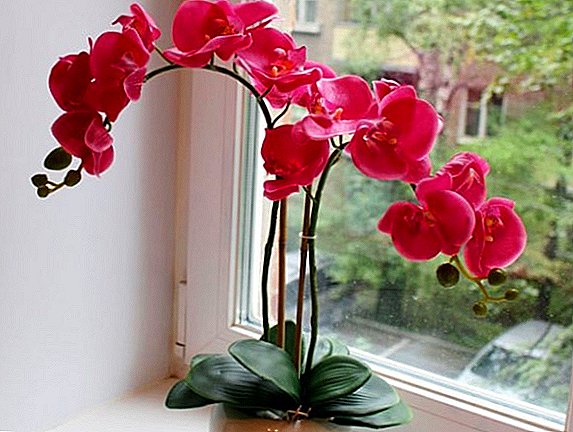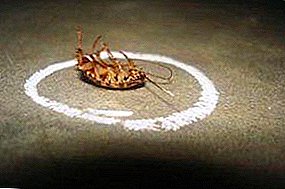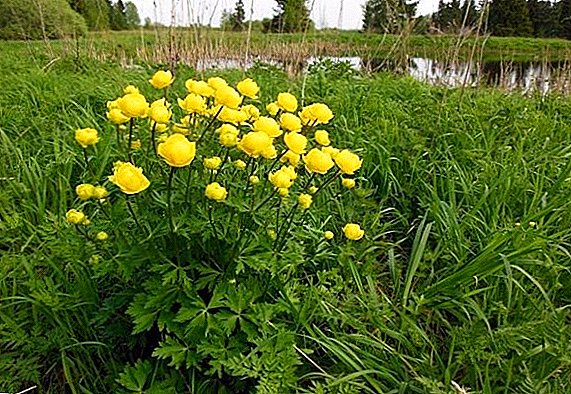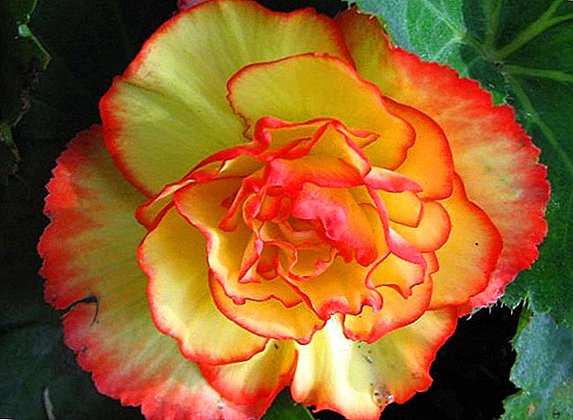 Anthurium "Scherzer" is popular with fans of this kind of plants due to the interesting colors of inflorescences and unpretentious covers.
Anthurium "Scherzer" is popular with fans of this kind of plants due to the interesting colors of inflorescences and unpretentious covers.
We learn how this flower looks, what varieties are known, the conditions and care it needs, how to propagate and what to use in the fight against diseases and pests.
Botanical description of the plant
This type of anthurium has a very short stem and short stature. Petioles 4–20 cm long with dark green leaves in the form of a lancet. They are never larger than the leaf plate itself. Inflorescences grow to the level of foliage or slightly higher.  The spikelet inflorescence is spirally twisted or curved, has a color ranging from pale orange tones to red shades. The veil is most often of bright, red or orange colors, but now their other colors are also displayed. Inflorescence with a veil does not fade for a long time.
The spikelet inflorescence is spirally twisted or curved, has a color ranging from pale orange tones to red shades. The veil is most often of bright, red or orange colors, but now their other colors are also displayed. Inflorescence with a veil does not fade for a long time.
Did you know? The first anthurium became known for its botany from France, Edward Andre, who in 1876 traveled as part of an expedition to the west of the Andes.
Sorta
In the Scherzer Anthurium, breeders have already deduced about 40 forms.
Consider the most famous of them:
- Mix. These are the most popular hybrids from the most different colors of bedspreads, which are often planted in one container. Differs in the small size and unpretentiousness.

- Lacetti. It has inflorescences suitable for cutting, with a pink veil and a well-twisted coil.
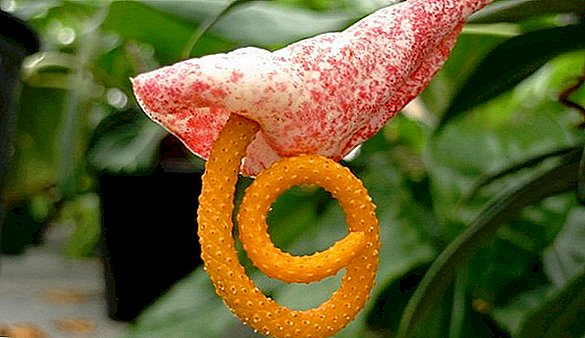
- Graffiti. A common hybrid that has a wide white bedspread with red dots.
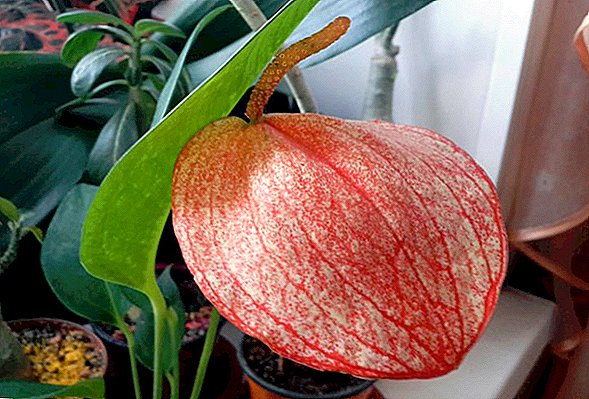
- Amaretti. These hybrids can have two colors (red, white, yellow, orange, pink, green). The cover is of one color, and speckles are of another.
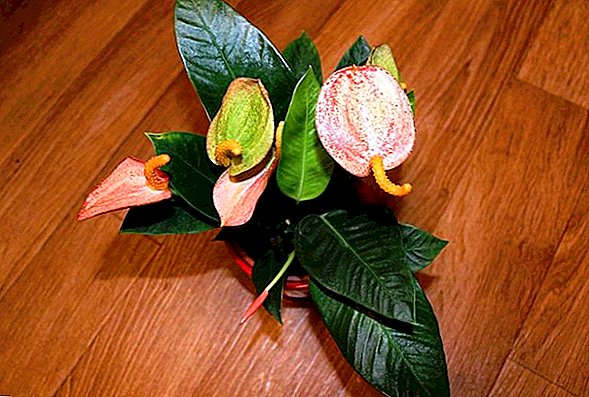
- Alexia Blue. Differs rare for this genus of plants blue color bedspreads.

- Chocolate Love. It has a smooth green ear and chocolate-colored bedspread.

- Rubens. His bedspread is painted in two colors. The middle part is pink and the rest is green.
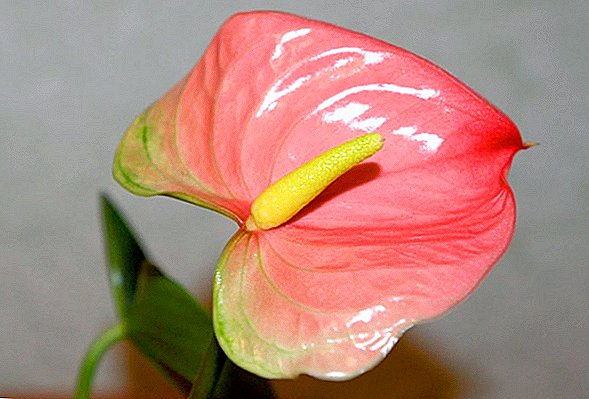
- Hawaii. He is known for color consisting of two or three colors.
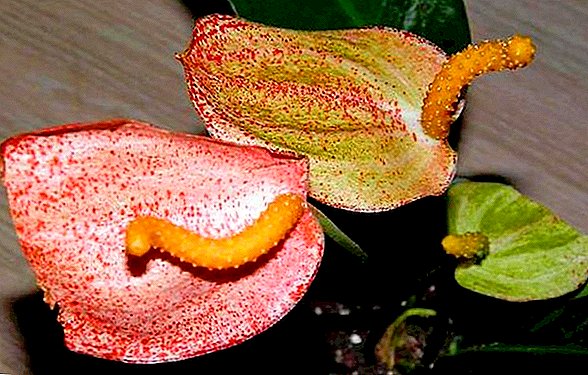
Find out which anthurium varieties are popular with gardeners.
Growing conditions
Anthurium "Scherzer" has certain requirements for the room where it is kept.
Lighting
Anthurium prefers the prosperity of diffused light, so it will suit the western or eastern windows.
On the southern windows it will need to shade in the period of active sun, otherwise the plant will get burns. In winter, a short day of light is recommended to lengthen with artificial lighting.
Humidity and temperature
This room flower is demanding of air humidity (90%). It needs to be sprayed daily or put in a pan with wet pebbles. He will suit rooms with high humidity (bathroom, kitchen).  Summer temperature should be within + 20 ... + 25 ° C. In winter, the temperature is lowered to + 15 ... + 18 ° C. Do not allow the temperature to drop below + 10 ° C. Draft must be absent.
Summer temperature should be within + 20 ... + 25 ° C. In winter, the temperature is lowered to + 15 ... + 18 ° C. Do not allow the temperature to drop below + 10 ° C. Draft must be absent.
Did you know? 926 species of anthurium are now known, but only some of them are used as indoor plants.
Home care
Caring for an anthurium "Scherzer" is easy.
Watering and spraying
Soil in the pot should not dry out, but stagnant water is unacceptable. Water should be taken soft, room temperature.
Water from the tap for softness can boil and cool, or defend, and then add a little vinegar. Spraying should also be done with boiled water at room temperature.  Watering is carried out when drying the top layer of soil. It is made abundant, and then drained from the pan. In the heat, the plant is watered more often, and in winter at lower temperatures the number of waterings decreases.
Watering is carried out when drying the top layer of soil. It is made abundant, and then drained from the pan. In the heat, the plant is watered more often, and in winter at lower temperatures the number of waterings decreases.
Learn more basic rules for caring for anthurium.
Top dressing
Anthurium "Scherzer" should be fed the whole year, but in the summer it is done every 2 weeks and in the winter every 4 weeks.
Young plants continue to feed the first six months of their lives 2 times a month and in the cold, but only half the dosage for adult plants is used for them.
When making dressings, it is recommended to alternate between mineral fertilizers and organic matter.
As organic you can use the following:
- mullein - 1 table. spoon to 1 liter of water;
- chicken litter - 1 tsp. spoon on 1 l.
 For feeding in the home, you can use such tools:
For feeding in the home, you can use such tools:
- Slept tea brewing (coffee).
- Dry yeast. In 5 liters of water diluted ½ tea. spoons of yeast and 2 table. spoons of sugar. Insist 24 hours. The resulting mixture is diluted with water in a ratio of 1: 5.
- Citrus peel. The crushed citrus skin is poured with water and allowed to infuse for several days.
- Ash. In 1 l of water part 1 table. spoon of ash powder.
- Onion Husk Broth. Take 50 grams of husk and pour 0.5 liters of boiling water. Then boil for 10 minutes, insist 4 hours and filter.
Among the finished mineral complexes can be used year-round "Kemira Lux".
When the plant blooms, it will be useful to him weekly foliar dressing. For them, you can take ready-made fertilizer "Dr. Foley Orchid."
Pruning
In Anthurium, wilted, diseased, and discolored leaves are pruned. It is also recommended to cut the sheets, which are too thickened by the plant.
Trimming is done with a sharp sterile tool from top to bottom.
Read also how to care at home for Anthurium Andre.
Transfer
This room flower needs to be replanted annually for the first 4 years. Then an adult copy needs to be transplanted every 2-3 years. This process should be carried out in the spring (March-April).
First of all, you need to pick up a wider (3 cm) pot with a drainage hole. Then you should pick up the ground.
Soil for planting can be purchased at the garden store, and you can prepare yourself.
Video: Anthurium Transplant Secrets
It is good to make the following soil mixture - 1 part of leafy ground, 1 part of peat, ½ part of perlite or river sand, ½ part of pine bark.
Important! Turf ground for planting and transplanting anthurium is no good. It can clog the pores of the root system, which will deprive it of air and nutrient access.
At the bottom of the pot must be placed a layer of drainage layer of expanded clay or pebbles. For transplantation using the method of transshipment, that is, together with the earth lump.
The transplant process itself is carried out as follows:
- On top of the drainage layer poured a small layer of prepared soil.
- Carefully withdraw the plant. To make it easier to get, you can pre-pour the soil along the edge of the pot.
- Place the plant in the center of the new pot and gently cover it with soil, slightly tamping it down during the process. At the same time, the root neck should be 1-2 cm under the ground, and 2 cm for sphagnum should remain up to the edge of the pot.
- Water the plant.
 Then the pot should be placed in a permanent place.
Then the pot should be placed in a permanent place.Breeding
Propagate anthurium "Scherzer" can be a variety of ways.
It will be useful for you to find out why anthurium does not bloom and what to do.
Cuttings
During reproduction of anthurium, it is necessary to cut off the top of the plant with a sharp knife. The stalk should have 2-3 internodes.
Such planting material is dried for 15 minutes, and then placed in a container with water. It is desirable to put activated carbon in the water.  Water should be added as needed. You can also place the cuttings in moist sphagnum. Roots appear after about 14-21 days. Then the cuttings are planted in a prepared container with soil.
Water should be added as needed. You can also place the cuttings in moist sphagnum. Roots appear after about 14-21 days. Then the cuttings are planted in a prepared container with soil.
Seeds
Seed breeding option is troublesome and it is not recommended to use for seeds collected from hybrids, as the varietal characteristics can be lost.
Important! The seeds of this plant quickly lose their germination, and already since the third week it is noticeably reduced. Buying seed in the store usually does not make sense.
For varieties, the flower should first be pollinated in the first days of flowering. For this purpose, a brush is carefully carried out on the cob several times. This process is better if 2-3 plants are used.
These actions are repeated 2-3 times over several days. Fruit ripening lasts 9-12 months.
After cleansing from the pulp, ripe seeds should be quickly planted. Seed material is placed on the surface of the prepared soil, but do not fall asleep from above. They need only a little flatten to the soil and moistened with a spray of warm water.
Then the container with the landing covered with a plastic bag and moved to a warm place. Every day, the bag is raised for 15 minutes to air and moderately moisturize the soil from the sprayer.  Sprouts appear after 1-2 weeks. After the formation of two true leaves, and this is after about 6-8 weeks, dive for the first time. Then after 2 months, the dive process is repeated.
Sprouts appear after 1-2 weeks. After the formation of two true leaves, and this is after about 6-8 weeks, dive for the first time. Then after 2 months, the dive process is repeated.
When a plant produces 5-6 true leaves, it is planted in a separate container. Flowering occurs only in the third year.
Find out what provokes the yellowing of leaves from anthurium.
Dividing bush
Anthurium can multiply by dividing the bush. This is probably the easiest way to breed. It is usually used for flower transplantation. Side shoots (or kids) are separated from the parent plant with a well-honed knife.
Separated sprouts are planted in a separate container and moderate watering is carried out. In this case, the flowering plants can wait in the first or second year of cultivation. 
Diseases and pests of the variety
Anthurium "Scherzer" may be prone to some diseases mainly due to inadequate care of him.
Did you know? Anthurium is also called "male happiness." It is believed that this flower makes its owner strong and brave, brings success and prosperity to the house.Excessive waterlogging, low temperature in the room can cause him the appearance of fungal diseases.
Consider the most common of them:

- Smallpox. Often the reason for the appearance appears low air temperature at high humidity, spraying cool water. Manifested in the form of bumps on the leaves. In this case, the flower pot should be moved to a warmer place.
- Enati. Appears due to temperature fluctuations. Leaves become deformed and growths appear. In this case, you should adjust the temperature and conduct dressings that will strengthen the plant.
- Rot. Arises due to excessive watering. Initially white spots appear on the plant, but over time they darken. Root rot contributes to the withering of the indoor flower. It is necessary to remove the affected parts of the plant, and then apply fungicides ("Fitosporin", blue vitriol). It should also be a change of soil. At the same time, damaged roots are removed, and the soil for planting is necessarily disinfected.
- Septoria. Manifested in the form of brownish spots on the plant. This disease is treated the same way as rot.
- Rust. This fungal disease is found on the rusty raid on the leaves, which eventually begin to dry. The treatment is the same as with rot.
- Fusarium. Causes massive wilting of leaves, as well as pink color raid on the basal neck. It is necessary at the first signs to carry out processing "Fundazol".
- Mealy dew. Detect the disease can be on whitish plaque and twisting foliage. To combat the disease using chemical means "Fitosporin-M".
If the air in the room is dry, the Scherzer anthurium may be exposed to insect infestations.
Learn more about the major diseases and pests of anthurium.
Consider the main pests of this indoor flower:
- Aphid. Small insect green color. Parasitic mainly from the bottom of the leaves. Cause wilting and twisting of the leaves. Apply "Aktellik", "Karate".
- Shchitovka. Look in the form of brownish small plaques. For the fight used chemical preparation "Confidor".
- Spider mite. It is possible to identify this pest by the appearance of a thin web and yellowish inclusions on leaflets. In this case, the chemicals Aktellik, Oberon, Akarin should be applied.
- Thrips. Remind flies of small size. Leaflets with the defeat of such a pest acquires a yellowish-white color. Chemical agents "Karate" and "Aktellik" should be used.
Anthurium "Scherzer" need to create certain conditions. If this indoor flower is organized appropriate care, then you will wait for a long flowering and no diseases are not afraid of him.










